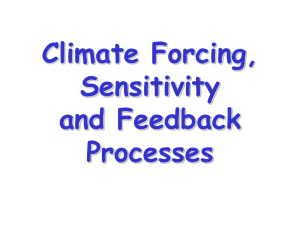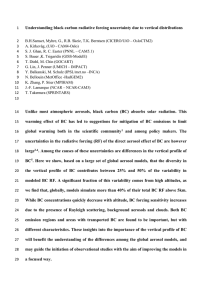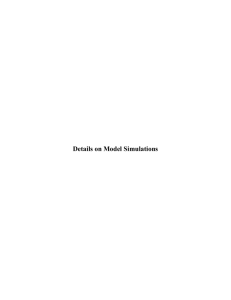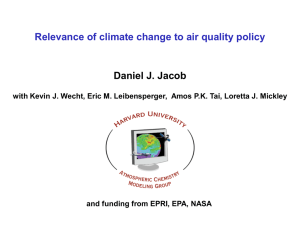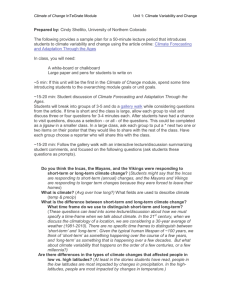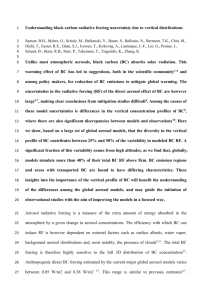Understanding black carbon radiative forcing uncertainty due to
advertisement
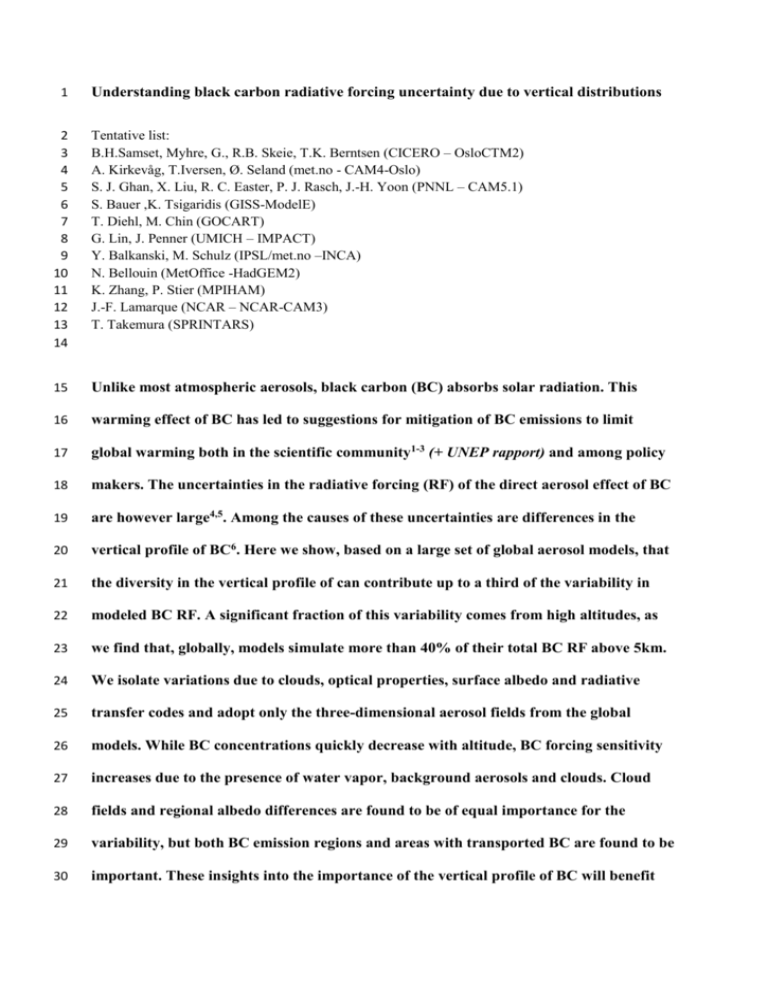
1 Understanding black carbon radiative forcing uncertainty due to vertical distributions 2 3 4 5 6 7 8 9 10 11 12 13 14 Tentative list: B.H.Samset, Myhre, G., R.B. Skeie, T.K. Berntsen (CICERO – OsloCTM2) A. Kirkevåg, T.Iversen, Ø. Seland (met.no - CAM4-Oslo) S. J. Ghan, X. Liu, R. C. Easter, P. J. Rasch, J.-H. Yoon (PNNL – CAM5.1) S. Bauer ,K. Tsigaridis (GISS-ModelE) T. Diehl, M. Chin (GOCART) G. Lin, J. Penner (UMICH – IMPACT) Y. Balkanski, M. Schulz (IPSL/met.no –INCA) N. Bellouin (MetOffice -HadGEM2) K. Zhang, P. Stier (MPIHAM) J.-F. Lamarque (NCAR – NCAR-CAM3) T. Takemura (SPRINTARS) 15 Unlike most atmospheric aerosols, black carbon (BC) absorbs solar radiation. This 16 warming effect of BC has led to suggestions for mitigation of BC emissions to limit 17 global warming both in the scientific community1-3 (+ UNEP rapport) and among policy 18 makers. The uncertainties in the radiative forcing (RF) of the direct aerosol effect of BC 19 are however large4,5. Among the causes of these uncertainties are differences in the 20 vertical profile of BC6. Here we show, based on a large set of global aerosol models, that 21 the diversity in the vertical profile of can contribute up to a third of the variability in 22 modeled BC RF. A significant fraction of this variability comes from high altitudes, as 23 we find that, globally, models simulate more than 40% of their total BC RF above 5km. 24 We isolate variations due to clouds, optical properties, surface albedo and radiative 25 transfer codes and adopt only the three-dimensional aerosol fields from the global 26 models. While BC concentrations quickly decrease with altitude, BC forcing sensitivity 27 increases due to the presence of water vapor, background aerosols and clouds. Cloud 28 fields and regional albedo differences are found to be of equal importance for the 29 variability, but both BC emission regions and areas with transported BC are found to be 30 important. These insights into the importance of the vertical profile of BC will benefit 31 the understanding of the differences among the global aerosol models, and may guide 32 the initiation of observational studies with the aim of improving the models in a focused 33 way. 34 The efficiency with which BC can induce radiative forcing is dependent on external factors 35 such as surface albedo, water vapor, background aerosol distributions and, most notably, 36 clouds (Haywood and Shine, 1997, Zarzycki and Bond, 2010). The total BC forcing is 37 therefore highly sensitive to the full 3D distribution of aerosol concentration (Samset and 38 Myhre, 2012). Anthropogenic BC forcing estimated by the current major global aerosol 39 models varies between 0.19 W/m2 and 0.38 W/m2 (Myhre et al, 2012, subm to Tellus?). This 40 range is little changed from previous estimates (Schulz et al, 2006, others?) Understanding the 41 causes of this variability in BC forcing would be a good step towards reducing the total 42 uncertainty on the total anthropogenic aerosol forcing. 43 Several studies have previously shown that the vertical transport is one area where the models 44 still differ significantly (Koffi et al, 2012, Schwarz et al, 2010). Using input from 11 global 45 aerosol models, we study the fraction of model variability in BC forcing attributable to 46 vertical differences alone. By combining the models’ own concentration profiles with a 47 common efficiency profile (EP) of RF per gram of BC (see Methods), we are able to 48 recalculate the induced RF of the BC direct aerosol effect at various altitudes and regions. We 49 can also separate out the contributions from the cloud field and variations due to regional 50 differences. 51 Figure 1a shows the global mean total BC burden from 11 global aerosol models participating 52 in AeroCom Phase 2, in addition to three models from AeroCom Phase 1. Individual numbers 53 are shown in Supplementary Table 1. We find a mean of 0.19 g/m2, but with a relative 54 standard deviation (RSD) of 32% and a model spread from 0.09 to 0.37 g/m2. Under an 55 assumption of equal forcing per gram, this alone will cause a large diversity in the total BC 56 forcing predicted by the models. AeroCom Phases 1 and 2 found a similar ranges, as shown 57 by the whisker boxes in Figure 1a. Note that the AeroCom P2 results are for BC from fossil 58 fuel burning (BCFF) only. Figure 1b shows the RF for each model, recalculated from the 59 concentration profiles using a common 3D, time dependent RF per gram profile. That the 60 average is stronger than for previous estimates is due to the strength of the profile used (see 61 Methods for discussion). The spread is highly correlated (95%) with the spread in burden, 62 again due to the use of a common BC EP. However, dividing the recalculated RF by the 63 global means gives new global estimates of BC RF per gram, shown in Figure 1c. If all model 64 vertical profiles were identical, this spread would vanish. It therefore carries information on 65 the impact of the vertical profiles of BC concentration on the model spread, separate from the 66 variability due to burden differences. 67 For AeroCom P1 and P2, the RSDs of the burden and RF per gram (quantifying the amount of 68 aerosol and the effect they have, respectively) are of approximately equal value, ranging from 69 32% to 46%. The two estimates are however internally correlated (Schulz 2006), such that the 70 spread in RF is less than if we simply combine the uncertainties. Our RSD in RF per gram is 71 16%, or 40% of that from AeroCom P1 and P2. Vetoing models in the P1 and P2 results that 72 have known issues (see Methods) brings this fraction up to 50%. Temporarily ignoring the 73 correlations, the vertical distributions can therefore be said to cause approximately 25% of the 74 spread in BC RF. Correlations are however mainly important between factors that are 75 independent of the vertical profile, and its importance is therefore likely to be higher than this 76 estimate. QUANTIFY IN METHODS, GIVE CONCLUSION. 77 As also shown in previous model comparisons (Shwarz 2010, more?), there are large 78 differences in the modeled BC vertical concentration profiles. Figure 2 shows the annual 79 mean vertical profiles of BC concentration from all models, globally and for two selected 80 regions (Arctic and China, see Methods for definitions). The Arctic is a region with no 81 indigenous BC emissions, but where the effects of transported aerosols are often discussed 82 (REF?). While all models show a significant BC contribution at high altitudes the model 83 spread in the Arctic is quite large, ranging from virtually constant below 200hPa to double- 84 peaked structures with maxima at 900 hPa and 200hPa. This highlights the differences in 85 transport schemes between the climate models. There is no discernible trend between the 86 AeroCom P1 and P2 models. China has heavy BC emissions at the surface, and also sees 87 contributions from transport at high altitudes, as is evident from Figure 2c. 88 Figure 2d-f shows the corresponding recalculated RF per meter of height, divided by the 89 model global mean burden. The resulting vertical profiles show at what altitudes RF is 90 generated, globally (2d) and for the two regions (2e-f). The interplay of the concentration 91 profiles, declining with altitude, and the RF per gram, increasing with altitude, is evident for 92 all regions. Globally, RF can be seen to be mostly induced in a range around 800hPa for most 93 models, with a secondary peak between 400hPa and 200hPa for some models. The China 94 region follows the global pattern, but with the low altitude peak closer to the ground, 95 reflecting the emissions there. The Arctic region, however, has a strong peak at high altitudes 96 for most models, evidencing the relative importance of high altitude BC RF there. 97 Figure 2g-i illustrate the model spread in forcing at a given altitude due to vertical profiles, by 98 integrating the absolute forcing per model layer from the surface and upwards. Globally, the 99 majority of models reach 50% of their forcing around 500hPa (approximately 5km), however 100 there is a large spread around this value. For the regions, this picture is quite different. In the 101 Arctic all models have a significant forcing component above 5km, while for the industrial 102 regions of China the opposite is true. 103 We find a significant fraction of modeled BC RF from high altitudes, with a notable regional 104 pattern. Figure 3 maps the model mean fraction of induced forcing (3a) and aerosol mass (3b) 105 from model layers of altitude above 500hPa. Firstly, the distinction between emission regions 106 of BC and regions that see mostly transported BC is evident. The former have small mass and 107 RF fractions at high altitudes, typically 10-20%, while transport regions show RF fractions up 108 to 80%. Figure 3c compares the model mean fractions and spreads globally and for three 109 regions (Arctic, China and Europe). Note that the fraction of RF above 5km is systematically 110 higher than the mass fraction, due to the strongly increasing shape of the RF efficiency 111 profiles. Globally, more than 40% of the model simulated RF from BC comes from model 112 layers above 5km, while only 24% of the mass is found in this region. This illustrates the 113 importance of validating model vertical profiles and transport codes not only in industrial 114 regions, but also in transport regions with low indigenous BC emissions. 115 Supplemental figure 1 shows the RF and mass fractions in four altitude bands, globally and 116 for the three regions. Such information is useful for comparing models with observational 117 data, and for constructing best estimates for global BC forcing. 118 We have shown that, even on global mean, a significant fraction of the variability in the BC 119 forcing per gram is due to differences in vertical profiles. It is however instructive to further 120 divide this variability into the components inherent in the efficiency profiles. In Figure 4a we 121 show the zonal mean RF per gram for all models, and investigate the relative importance of 122 the cloud field and of regional differences in albedo for the resulting spread. In Figure 4c we 123 have run the analysis using a global, annual mean efficiency profile instead of the full time 124 dependent 3D profile, and in addition used clear sky conditions. The solid line shows the 125 model mean forcing per gram, and the dashed lines show the maximum and minimum values 126 from individual models. The magnitude can be seen to be virtually independent of latitude, 127 due to the global profile masking the effects of varying surface albedo, and to have a low but 128 non-vanishing spread. As shown in Samset and Myhre 2011, not all vertical sensitivity of BC 129 forcing is due to the aerosols being above or below clouds. The remainder, caused 130 predominantly by Rayleigh scattering, water vapor and the competing effects of other aerosols, 131 is the cause of the variability here. RSD on global mean values is 10% (see Figure 4b). Figure 132 4d shows the same analysis using the full 3D efficiency profile. The RSD increases to 13%, 133 and we now see the latitudinal effects of the high polar albedo. Figure 4e shows the analysis 134 using the global mean efficiency profile again, but under all-sky conditions. Again the RSD 135 increases to 13%, due to the cloud field. The model variability in forcing efficiency that is due 136 to vertical profile differences can therefore be decomposed into three factors: Equal and 137 significant contributions from the cloud field and from and from regional differences, and a 138 major contribution from the underlying sensitivity of BC forcing to altitude even in the 139 absence of clouds and albedo differences. Harmonizing model treatment of clouds and albedo 140 is therefore not sufficient to remove uncertainties in BC forcing due to vertical profiles. 141 Results in the present study are given for total BC aerosol emissions only. However, due to 142 different source regions, the vertical profiles of BCFF could be different from BC. Six models 143 also provided concentration profiles for BCFF. Using the same efficiency profiles we 144 performed the analysis also for BCFF, and found results consistent with what we have 145 presented for BC (not shown). While the absolute forcing numbers differ due to lower total 146 burdens for BCFF, the variability in vertical profiles is very similar to that for total BC. Our 147 conclusions here are therefore also applicable to model comparison results on BCFF only. 148 In conclusion, we have shown that the previously documented large spread in BC aerosol 149 concentration profiles is enhanced for vertical BC RF profiles. Using 11 global aerosol 150 models, we show that most models globally simulate 40% of their BC forcing above 5km, and 151 that regionally the fraction can be above 70%. The spread between models is however quite 152 large, and we have indications that up to a third of the differences in modeled BC RF can be 153 attributed to differences in vertical profiles. To propose efficient mitigation measures for BC, 154 its radiative forcing needs to be well understood both in emission and transport regions. 155 Further model improvements and comparisons with data are needed, and should focus on both 156 of these types of region. It is however clear that while the BC vertical profiles are important, 157 they are not sufficient to explain the remaining differences between global aerosol models. 158 Methods 159 Model simulations 160 The AeroCom initiative asks models to simulate the direct aerosol radiative effect using the 161 same base years (2000 and 1850), with the same meteorology and microphysics. Two sets of 162 comparisons have been performed, here labeled AeroCom Phase 1 (P1 ref) and AeroCom 163 Phase 2 (P2 ref). For the present study, monthly 3D BC concentration fields from 11 global 164 aerosol models participating in AeroCom Phase 2 are used. Supplementary table 1 lists the 165 models, descriptions can be found in Myhre et al 2012 and references therein. For six of the 166 models, concentration fields of BC from fossil fuel burning only (BCFF) are also used. Three 167 of the same models also provided BC concentration profiles to AeroCom Phase 1. These 168 fields are also included here, as separate models since the all three have seen heavy 169 development in the intervening years. The concentration fields and the 3D model resolutions 170 are the only inputs taken from each separate model. The 1850 concentrations are subtracted 171 from the 2000 ones, leaving the contribution due to anthropogenic BC or BCFF emissions. 172 RF recalculation 173 Samset and Myhre 2011 presents a set of vertical profiles of the direct radiative forcing per 174 gram of aerosol for BCFF, i.e. the amount of top-of-atmosphere shortwave radiative forcing 175 seen by a particular model (OsloCTM2) per gram of aerosols at a given altitude. Here we term 176 these efficiency profiles (EP). In the specialized literature, the term normalized radiative 177 forcing is more commonly used. Here we employ the full time dependent 3D efficiency 178 profiles, either for all sky or clear sky conditions as described above. We find the forcing per 179 gram BC for each model grid point and time step, and then calculate the contribution to the 180 shortwave, top-of-atmosphere BC radiative forcing by multiplying in the modeled BC 181 concentration. This gives us intercomparable 3D RF fields, something that is not immediately 182 available from each model. We label this the recalculated RF, to emphasize that it is heavily 183 correlated with the burden and should not be taken directly as an estimate of BC forcing of 184 each model. Since the model that was used to produce the profiles of RF per gram has among 185 the strongest global mean forcings per gram (Myhre et al 2012), most recalculated RFs can be 186 expected to be stronger than their host model would predict. However, by dividing the 187 recalculated RF by the total aerosol burden of the host model, we extract the variability in 188 forcing per gram from each model that is due only to vertical profiles, and can subsequently 189 use the vertical RF profiles to study it. 190 As this method removes contributions to the spread in BC RF due to differences in model 191 specific treatment of clouds, water uptake and microphysics, we are left solely with variations 192 due to the concentration profiles and the total aerosol load. Dividing by the load, we can study 193 the contribution to the variability due to regional differences (high or low surface albedo, 194 indigenous emissions, transport region or both), and due to the presence of clouds. To study 195 the latter effects, we ran parallel analyses using only a global mean profile of RF per gram 196 (labeled GP above), a distinct profile of RF per gram for clear sky conditions (labeled CS), or 197 both (labeled CSGP). 198 Region definitions 199 For the present analysis, “Europe”, defined as the box of longitudes -10 to 30, latitudes 38 to 200 60, “China” which covers longitudes 105 to 135, latitudes 15 to 45, and “Arctic” which 201 covers latitudes 70 to 90. Europe and China represent regions with high industrial BC 202 emissions and significant fractions of the global BCFF emissions, making their total BC 203 forcing sensitive to pure vertical transport and wet scavenging. The Arctic is a region with 204 low indigenous emissions, but important BC contributions at high altitudes transported from 205 other regions. Its total BC forcing is therefore sensitive to model differences in vertical and 206 long range transport. 207 208 References 209 210 211 212 213 214 215 216 217 218 219 220 221 1 222 223 2 3 4 5 6 Grieshop, A. P., Reynolds, C. C. O., Kandlikar, M., and Dowlatabadi, H., A blackcarbon mitigation wedge. Nature Geoscience 2 (8), 533 (2009). Hansen, J. et al., Global warming in the twenty-first century: An alternative scenario. Proceedings of The National Academy of Sciences of The United States of America 97 (18), 9875 (2000). Nature_Editorial, Time for early action. Nature 460 (7251), 12 (2009). Ramanathan, V. and Carmichael, G., Global and regional climate changes due to black carbon. Nature Geoscience 1 (4), 221 (2008). Schulz, M. et al., Radiative forcing by aerosols as derived from the AeroCom presentday and pre-industrial simulations. Atmospheric Chemistry and Physics 6, 5225 (2006). Zarzycki, C. M. and Bond, T. C., How much can the vertical distribution of black carbon affect its global direct radiative forcing? Geophysical Research Letters 37, L20807 (2010). 224 Tables 225 226 227 228 Table 1: Modeled BC burden, RF calculated by use of full 3D efficiency profiles (RF) or by a global mean profile (RFGP), and forcing per gram (NRF). All numbers shown for global mean and for three selected regions. RF_fraction shows the fraction of the total BC forcing simulated within the stated region. M>5km and RF>5km show the fractions of aerosol mass and RF, respectively, simulated above an altitude of 5km (500hPa). Global Model NCAR-CAM3.5 CAM4-Oslo CAM5.1 GISS-modelE GOCART-v4 HadGEM2 IMPACT INCA MPIHAM OsloCTM2 SPRINTARS CAM4-Oslo-P1 IMPACT-P1 OsloCTM2-P1 Mean Std.dev Europe Model NCAR-CAM3.5 CAM4-Oslo CAM5.1 GISS-modelE GOCART-v4 HadGEM2 IMPACT INCA MPIHAM OsloCTM2 SPRINTARS CAM4-Oslo-P1 IMPACT-P1 OsloCTM2-P1 Mean Std.dev 229 230 Burden [mg/m2] 0.14 0.22 0.09 0.21 0.19 0.37 0.17 0.23 0.18 0.20 0.19 0.17 0.19 0.19 0.19 0.06 RF [W/m2] 0.25 0.54 0.16 0.40 0.38 0.81 0.24 0.41 0.26 0.40 0.37 0.34 0.30 0.27 0.37 0.16 NRF [W/g] 1801 2445 1655 1905 1982 2185 1450 1833 1492 2003 1959 1955 1546 1477 1835 290 RFGP [W/g] 0.27 0.57 0.18 0.44 0.41 0.86 0.28 0.45 0.31 0.44 0.41 0.36 0.34 0.33 0.40 0.16 RF fraction [%] 100 100 100 100 100 100 100 100 100 100 100 100 100 100 100 0 Mass>5km [%] 20.3 46.0 18.1 30.1 27.1 33.6 5.8 28.9 10.8 30.1 30.3 26.4 14.2 11.7 23.8 10.8 RF>5km [%] 39.3 64.7 36.4 56.4 46.3 50.6 13.1 53.8 25.7 48.3 54.2 46.9 30.7 24.2 42.2 14.5 Burden [mg/m2] 0.20 0.36 0.21 0.62 0.30 0.58 0.36 0.45 0.39 0.30 0.23 0.36 0.50 0.38 0.37 0.13 RF [W/m2] 0.27 0.73 0.25 0.79 0.48 1.09 0.37 0.54 0.41 0.47 0.38 0.52 0.54 0.45 0.52 0.22 NRF [W/g] 1386 2029 1230 1276 1626 1864 1036 1206 1052 1557 1658 1425 1081 1189 1401 308 RFGP [W/g] 0.32 0.80 0.30 0.91 0.54 1.20 0.45 0.63 0.47 0.54 0.43 0.59 0.63 0.53 0.60 0.24 RF fraction [%] 1.15 1.41 1.70 2.03 1.34 1.40 1.61 1.37 1.62 1.23 1.08 1.62 1.87 1.71 1.51 0.27 Mass>5km [%] 16.2 36.2 9.1 16.5 21.6 27.3 4.3 17.4 5.8 19.5 27.9 16.5 8.5 5.9 16.6 9.5 RF>5km [%] 40.8 60.1 25.0 43.6 44.0 47.4 13.0 49.6 19.4 41.0 58.7 38.5 24.9 16.0 37.3 15.2 Arctic Model NCAR-CAM3.5 CAM4-Oslo CAM5.1 GISS-modelE GOCART-v4 HadGEM2 IMPACT INCA MPIHAM OsloCTM2 SPRINTARS CAM4-Oslo-P1 IMPACT-P1 OsloCTM2-P1 Mean Std.dev China Model NCAR-CAM3.5 CAM4-Oslo CAM5.1 GISS-modelE GOCART-v4 HadGEM2 IMPACT INCA MPIHAM OsloCTM2 SPRINTARS CAM4-Oslo-P1 IMPACT-P1 OsloCTM2-P1 Mean Std.dev Burden [mg/m2] 0.05 0.20 0.02 0.16 0.14 0.34 0.05 0.07 0.03 0.07 0.08 0.12 0.11 0.02 0.10 0.09 RF [W/m2] 0.20 0.79 0.07 0.64 0.52 1.19 0.16 0.29 0.11 0.27 0.34 0.46 0.35 0.07 0.39 0.31 NRF [W/g] 3907 3877 4187 3889 3746 3465 3214 4016 4078 3879 4413 3716 3266 3637 3806 335 RFGP [W/g] 0.16 0.60 0.06 0.49 0.38 0.86 0.11 0.24 0.08 0.21 0.26 0.34 0.26 0.05 0.29 0.23 RF fraction [%] 2.47 4.41 1.41 4.74 4.15 4.40 1.95 2.12 1.21 2.03 2.77 4.10 3.48 0.74 2.85 1.34 Mass>5km [%] 63.2 60.9 81.6 65.7 53.2 40.3 35.9 78.8 75.5 71.0 83.1 48.9 39.4 63.0 61.5 15.9 RF>5km [%] 76.1 71.0 88.5 77.2 64.1 52.1 48.1 89.2 89.2 82.4 89.9 61.1 52.9 80.4 73.0 15.0 Burden [mg/m2] 0.89 0.84 0.65 1.60 1.12 2.08 0.83 1.06 1.31 1.27 1.33 0.67 0.96 0.84 1.10 0.39 RF [W/m2] 1.17 1.35 0.74 1.89 1.50 3.29 0.94 1.27 1.39 1.95 1.66 0.89 0.87 1.00 1.42 0.66 NRF [W/g] 1312 1612 1139 1185 1340 1581 1138 1198 1061 1544 1248 1336 904 1189 1270 202 RFGP [W/g] 1.42 1.55 0.93 2.43 1.82 3.82 1.21 1.53 1.80 2.26 2.04 1.06 1.20 1.27 1.74 0.75 RF fraction [%] 8.88 4.66 8.87 8.78 7.46 7.61 7.32 5.70 9.85 9.17 8.30 4.96 5.41 6.82 7.41 1.69 Mass>5km [%] 9.7 22.7 8.1 10.4 11.3 15.9 3.3 13.7 2.8 15.4 10.2 10.5 5.6 6.6 10.4 5.3 RF>5km [%] 25.0 48.3 24.4 30.5 28.4 34.2 9.2 40.8 9.1 33.0 28.3 27.4 19.8 18.1 26.9 10.9 231 Figures 232 233 234 235 Figure 1: Modeled BC global mean (a) burden, (b) RF and (c) RF per gram BC. Yellow boxes indicate mean, one standard deviation and max/min values. Mean values and spreads for AeroCom P1 and P2 (hatched whisker boxes) are taken from Schulz et al 2006 and Myhre et al 2012 respectively. 236 237 238 239 240 Figure 2: (a-c) BC concentration vertical profiles, global mean and for two selected regions. Overlain is the annual mean forcing efficiency profile for the selected region. Solid lines show AeroCom P2 submissions, dashed lines show P1. (d-f) BC RF per height, divided by the modeled global mean BC burden, globally and for three selected regions. (g-i) Vertical profile of integrated absolute BC RF. Lines indicate the 50% mark and 500hPa altitude. 241 242 243 244 245 246 Figure 3: (a) Fraction of modeled BC RF above 5km. (b) Fraction of modeled BC mass above 5km. (c) Mean fraction of mass (orange) and RF (yellow) globally and for three selected regions. Boxes indicate one standard deviation on the model spread, whiskers show maximum and minimum values. 247 248 249 250 251 252 253 254 Figure 4: Breakdown of spread in BC RF per gram. (a) Zonal mean of BC RF per gram using 3D efficiency profiles and all sky conditions, for all models. (c-e) Model mean (solid line) and maximum/minimum (dashed lines) when instead using (c) a global, annual mean efficiency profile and clear sky conditions, (d) 3D profile and clear sky conditions, and (e) a global profile and all sky conditions. (b) shows the global mean values for the four cases. Boxes show one standard deviation on the model spread, whiskers show maximum/minimum values. 255 256 257 258 Supplementary figure 1: Mass and forcing fractions in four altitude bands, globally and for three regions. Yellow boxes show mass fractions, orange boxes show RF fractions. (a) Global mean, (b) Arctic, (c) Europe, (d) China.
